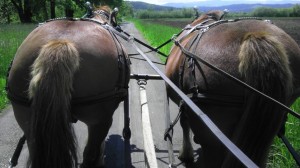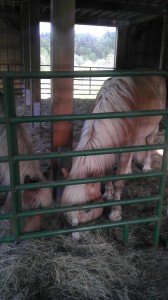 I am simply incapable of resisting a farm. When the weather turns warm, I must visit some. There’s just no cure for this addiction.
I am simply incapable of resisting a farm. When the weather turns warm, I must visit some. There’s just no cure for this addiction.
This year, I’ve been touring western Oregon. It’s such a beautiful place. The land is rich and grows a huge range of crops from grains to nuts to grapes to, well, nearly everything. The farms are small enough that the crops create a beautiful patchwork across the rolling hills. As I was driving south out of Portland, walnut trees flowed into golden fields of wheat, which turned into vineyards, pastures, cornfields and rows of produce. Rain or shine, everything has a richness, an abundance about it.
My first stop was Belle Mare farm. Susan farms her 60 acres using horses, especially her Suffolks. She grows a variety of grains and raises animals, producing organically-grown (non-certified) animal feed for other farmers. The one problem she has is a lack of land-line internet access, although the lines are on her street. She makes up for it using wireless for now. Hopefully, the land lines will reach her farm soon. (P.S. Susan, see my last posting for some hints on how to prod the company a bit.)
She and I then visited Big Table Farm and tasted a few varietals from their winery. Amazing! I always enjoy a good Syrah, but they also had a Chardonnay that was just outstanding. They have a lovely web site and with great descriptions of their wines. The labels are very interesting, too.
On my second trip south, I travelled the Oregon Coast. Since many of the restaurants there purchase from local farms, I found that I was able to eat really well. Wines and cheeses are everywhere, along with tons of seafood. Not being of a particularly sporty nature, I enjoyed the culinary atmosphere and mostly tucked my toes into the sand on the beach while reading a good science-fiction between meals. (Yes, that’s my idea of the perfect vacation.) For those more prone to hiking, biking, surfing, etc., there’s so much to do. I strongly encourage a vacation there at least once in your life.
Oh dear, I’ve been talking about food quite a bit. It must be time for dinner…
Oh, that’s better. Good, fresh farm food is just the best thing for dinner. Okay, now I can talk about how these two farms, Belle Mare and Big Table, are using online technology to effectively communicate with their customers. They are both small farms in the same area but with different business models, each requiring a unique approach.
Big Table Farm reaches out to more traditional customers, selling directly to the public. They have a web site, with a shopping cart, where you can buy wines right online. They also have a Facebook page that keeps people up to date on the progress of the new winery being constructed on the farm.
Belle Mare Farm, on the other hand, sells to other farmers. Farmers may not spend tons of time on a computer but they usually have cell phones, many of them smart phones. That’s why text messaging and social media, such as Twitter and Facebook, are a great way to keep in touch with those customers. You don’t really need a web site if you can make your sales through word of mouth, but you still need a way to keep in touch with those customers. Social media works for that. For those customers who have only traditional phones, giving them a call works just fine.
The way to determine how to best use technology for your small business is to create a marketing plan. (What?) Yes, a marketing plan. If you’ve never made one before, it’s always a good exercise in understanding how you interact with your customers. It can also show you new ways to reach more customers. My next entry will have more about Marketing Plans and where you can get templates and guidance.


